The Greek style in the interior embodies harmony and simple elegance. It fits people who are classic, clear zoning of space. For decoration of rooms in the antique style they use beautiful stucco, columns and sculpture. The walls are decorated with frescoes and large mirrors in metal frames. The ceilings are decorated with coarse, not hewn stone, laid wooden beams, or simply whitened. Furniture is selected strict, classic with one-colored upholstery. Being in a Greek-style room is comfortable and pleasant: nothing irritates the eyes. The harmony of space is combined with the harmony of the interior.
What do we remember when we mention the Greek interior decoration culture? Colonnades, arched openings, niches with fountains and sculptures, murals depicting the feats of famous mythological heroes. All these components characterize the ancient Greek culture. It serves as a good support for creating antique-style furnishings. The appearance of modern Greece is formed by completely different components: sandy beaches of the Aegean and Mediterranean seas, plantations of olive trees, delicious wine from the vine, national cheeses. Designers have a hard time relying on modern Greek culture. To embody its basic principles, they take as a basis the Mediterranean color scheme, the national color. But also intertwined unobtrusive elements of antique decor.
Creating an interior in the Greek style, you can rely on the historically established antique style or simplified modern Greek style. Designers often combine two directions, skillfully weaving them into each other.
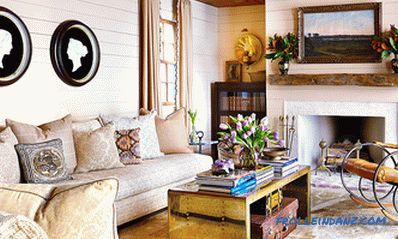
The history of the emergence of the Greek style
One of the most ancient styles of interior began to take shape at the time of the birth of Greek culture. Around the third millennium BC. e. At that time, Greek society was not formed into a fully-fledged developed state. The Greek lands were inhabited by disparate tribes who settled in the coastal zones of the Mediterranean, Aegean seas. The state system was formed approximately in the VIII-VI centuries. BC e. Speaking about the history of the interior in the Greek style, it is impossible not to say about the culture of ancient Greece as a whole. Since these concepts are strongly interrelated.

The culture of the ancient state developed rapidly. Historians divide the development process into five periods:
1. Archaic - dates from the reign of the legendary King Solomon. Evidence of the interior, the architecture of this period has not survived.
2. Early non-classical - cultures are freed from Egyptian influence, adapting the traditions of other countries to suit themselves, the Greek style known to us begins to emerge.
3. Classic - the heyday of culture. At this time, formed the main traditions of architecture and stone construction. The Greeks began to build not only strong, but also beautiful buildings, achieving the ideal form. They rule above all the golden mean to which they aspire in the construction of public and private buildings, interior design, decoration of courtyards and streets. It is noteworthy that instead of coarse simple materials they began to use more noble ones. Such as marble.
4. The Hellenistic period is characterized by grace of forms and images. It is formed under the influence of the culture of the East. Sculptors take care of the image of perfect human bodies, athletic and well-built. Painters paint portraits, taking care of the beauty of the composition, the right angle, perspective. On the canvases depict harmonious faces. In this period magnificent magnificent civil buildings - theaters, temples are built.
5. The period of Roman power contributed to the deep penetration of Greek culture into Roman culture. The Greeks stopped building colossal buildings in their native land, but continued their traditions in the Eternal City. Ancient Greek and Roman cultures are very similar. They are distinguished by the pomp of the decoration. Restraint and practicality are characteristic of Greek design. Every thing takes its place and is used for its intended purpose. Roman design is notable for ostentatious magnificence and decorative excess.

Each of the periods combined a certain social structure, methods of building monumental structures; periods of rule of historical personalities; principles of interior decoration. Common to all periods of cultural development is the use of Greek mythology as the basis for decorating, building, and visual arts. In the works of any period of time there are images of heroes: Theseus, Hercules, Prometheus. The theme of the struggle of the titans and gods is reflected in sculpture and painting. Greek gods dedicated temples, theaters.
The main features of the Greek style
In order to create an interior in the modern house in the Greek style, designers rely on the basic principles of the culture and history of Hellas.The fundamental features of the Mediterranean design of Greece are in the color scheme, methods of decorating flat surfaces, the choice of lighting, textiles and decor. 7 main features of the style form the appearance of the premises
1. The combination of white with natural colors of the area
Often, authentic Hellenic interiors are pure white. Floor, ceiling, walls, furniture - all white. Only the décor partly adds color to the clean palette of the room.

The theme of bright sunshine and blue sea is relevant for many modern interiors. Designers successfully combine white and blue, complementing their zigzag pattern of waves.

The muted colors, like faded in the sun, are considered to be characteristic: light green, sky blue, sandy, light beige.
2. Walls with a rough finish
For the decoration of the walls they use plaster, masonry, and deliberately uneven whitewash. The main thing is that the walls are not smooth. The surface is decorated with ornaments, frescoes, stucco, columns and semi-columns. In the spacious rooms in the walls make niches for statues or fountains.

3. High ceilings
The Greek architecture assumed buildings with high arches that were decorated with images of gods, heroes, or stucco. This option is possible today. The main condition for creating such a relief of ceilings is height. Low ceilings are simply whitened or painted. Sometimes white ceilings are decorated with wooden beams. It is desirable to arrange the walls and ceiling in a single color scheme, achieving a single space.

4. Grungy floor
Finishing materials for the floor are selected in the same style with the ceiling and walls. If they are decorated with wood, then the floor is made of wood. If they are plastered, then choose a rough tile of a light shade as a floor covering. Walls with brickwork complete with stone floors. The original Greek design of the Hellenistic period assumed the use of mosaic on the floor. Designers often adopt this technique when designing designs in the Greek style.

5. Natural textiles
Fabric decoration of rooms - discreet. Use natural fabrics - flax, cotton, bamboo fiber. Windows curtain curtains simple cut without excesses and draperies. Choose monophonic canvases with a characteristic pattern of graphic waves. It is important that every detail is not only for beauty, but also has practical application. For example, the curtains protect against bright light, the canopy of hell is a bed from mosquitoes, and the pillows on the sofa create comfortable seating conditions.

6. Simple lighting of rooms
The room should be bright in the afternoon and evening. Therefore, for lighting select the required number of lighting fixtures. No more and no less. If the room is small - enough central lamp. If the area is extensive, then it is illuminated by a central chandelier, wall sconces, floor lamps. Fixtures choose a simple geometric shape from natural materials.

7. Decor with an emphasis on historical past
Rooms are filled with attributes that directly indicate the traditions of Ancient Hellas: amphoras, sculptures of naked heroes, wooden courts. Columns, niches and stucco moldings can be counted as decorative elements. They decorate the interior and create a colorful atmosphere.

The color palette and characteristic patterns
A harmonious Greek interior allows the use of such color ensembles:

White and blue.

Sand and olive.

White and beige.
Most of the rooms are made out in a single color, without making any bright accents through, without allowing extra color spots.
To emphasize the Greek aesthetics of the decor of surfaces, use drawings and patterns:
1. The most common and recognizable pattern is a circle inscribed in a square, as a symbol of the beauty of forms and harmony;

2. Zigzags or graphic waves are the most common patterns depicted on curtains, tablecloths, walls and ceilings;

3. Floral ornaments and motifs.

Walls
In addition to pastel colors and frescoes, the following methods are used in the design of walls:
- A spacious room is decorated with white polyurethane columns, which are opened with several layers of paint (beige and white on top), then rub over the edges slightly. The impression of natural stone or marble, aged by time.
- The living room is decorated with a fireplace. They enclose it with patterned tiles or monophonic tiles.
- Arched niches are made in the walls. They can be left empty, or decorated with plants or sculpture.
- The walls are decorated with stone.
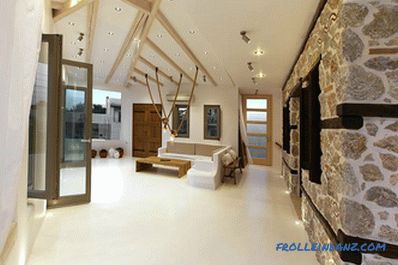
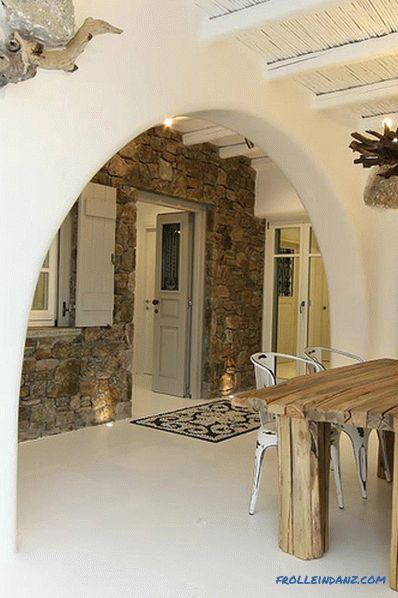

Ceiling
Classic finish - whitewashed ceiling without decorations.It is suitable for small rooms, allowing you to visually increase the area. Another thing - large spacious rooms. They are decorated with stucco around the perimeter. If possible - decorate with hand-painted, choosing scenes from Greek mythology. In the premises, made under the modern Greek style, the ceilings are decorated with wooden beams.

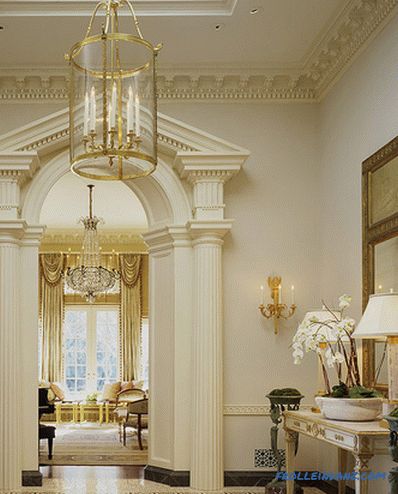
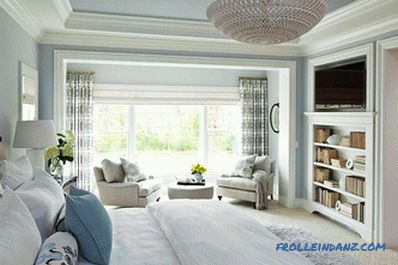
Floor
The floor is made according to the principle of wall and ceiling decoration. Natural natural materials are used to finish it:
- large pebbles;
- rough boards;
- stone or ceramic tiles;
- mosaics.
If the room is small, then the floor is made monophonic, covering it with a single material. For example, floorboard or tile.
If the dimensions of the room are large enough, then it is decorated more refined. The floor is laid artistically: multicolored small tiles, mosaic patterns.



Textiles
To make the textile design consistent with the national color, it is selected from simple natural materials:
- put square, oval or circular paths made of matting, mat or rough knitting on the floor;
- beds and sofas are covered with plain-colored bedspreads with a patterned edge;
- curtains curtain with white or light curtains (you can add them to the blinds).



Lighting Organization
Designers are very pleased with the choice of luminaires Seriously. It is the shape and materials of the lamps that largely distinguish the Roman and Greek designs. For the Hellenic interior is not typical large chandeliers with glass pendants and forged decorations. Such a lighting device can ruin the whole picture for you, turning a modest interior into a demonstration of luxury and wealth.
Tip: choose lamps of simple form (candlestick, torch, ball, hemisphere, cylinder) from natural materials (bronze, brass).



Decor
Rooms are decorated with natural, architectural and sculptural decor. Living decor is a vase with flowers and fruit, indoor plants (palm trees, ferns). Under the architectural decor understand arched doorways and window openings, colonnades, podiums. The sculptural decoration is busts, antique statues, fountains, stucco, large floor vases.


The modern interior in the Greek style allows the use of modern materials and techniques. It is important that the room turned out harmonious, not overloaded and cozy.




